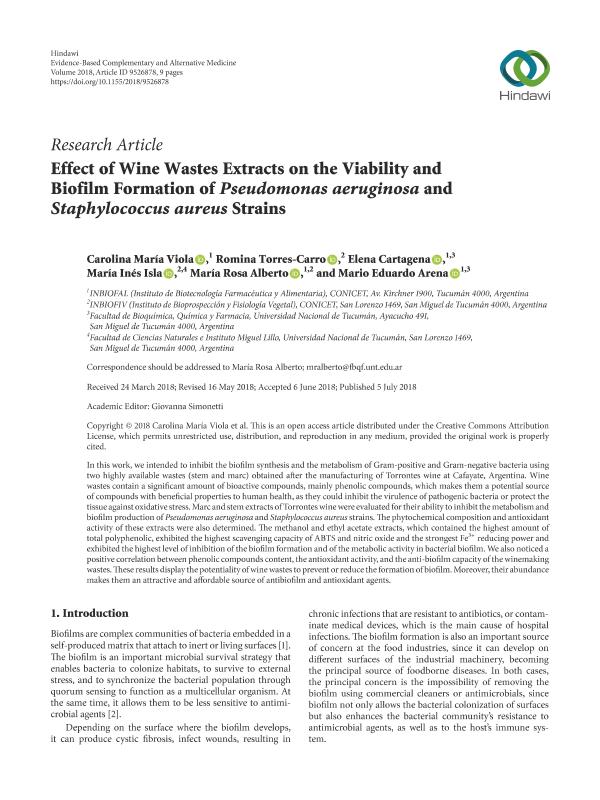Mostrar el registro sencillo del ítem
dc.contributor.author
Viola, Carolina Maria

dc.contributor.author
Torres Carro, Romina

dc.contributor.author
Cartagena, Elena

dc.contributor.author
Isla, Maria Ines

dc.contributor.author
Alberto, Maria Rosa

dc.contributor.author
Arena, Mario Eduardo

dc.date.available
2019-12-03T20:45:37Z
dc.date.issued
2018-07-05
dc.identifier.citation
Viola, Carolina Maria; Torres Carro, Romina; Cartagena, Elena; Isla, Maria Ines; Alberto, Maria Rosa; et al.; Effect of Wine Wastes Extracts on the Viability and Biofilm Formation of Pseudomonas aeruginosa and Staphylococcus aureus Strains; Oxford University Press; Evidence-Based Complementary and Alternative Medicine; 2018; 5-7-2018; 1-9
dc.identifier.issn
1741-427X
dc.identifier.uri
http://hdl.handle.net/11336/91280
dc.description.abstract
In this work, we intended to inhibit the biofilm synthesis and the metabolism of Gram-positive and Gram-negative bacteria using two highly available wastes (stem and marc) obtained after the manufacturing of Torrontes wine at Cafayate, Argentina. Wine wastes contain a significant amount of bioactive compounds, mainly phenolic compounds, which makes them a potential source of compounds with beneficial properties to human health, as they could inhibit the virulence of pathogenic bacteria or protect the tissue against oxidative stress. Marc and stem extracts of Torrontes wine were evaluated for their ability to inhibit the metabolism and biofilm production of Pseudomonas aeruginosa and Staphylococcus aureus strains. The phytochemical composition and antioxidant activity of these extracts were also determined. The methanol and ethyl acetate extracts, which contained the highest amount of total polyphenolic, exhibited the highest scavenging capacity of ABTS and nitric oxide and the strongest Fe3+ reducing power and exhibited the highest level of inhibition of the biofilm formation and of the metabolic activity in bacterial biofilm. We also noticed a positive correlation between phenolic compounds content, the antioxidant activity, and the anti-biofilm capacity of the winemaking wastes. These results display the potentiality of wine wastes to prevent or reduce the formation of biofilm. Moreover, their abundance makes them an attractive and affordable source of antibiofilm and antioxidant agents.
dc.format
application/pdf
dc.language.iso
eng
dc.publisher
Oxford University Press

dc.rights
info:eu-repo/semantics/openAccess
dc.rights.uri
https://creativecommons.org/licenses/by/2.5/ar/
dc.subject
MARC
dc.subject
STEM
dc.subject
ANTIOXIDANT
dc.subject
BIOFILM
dc.subject
POLYPHENOLS
dc.subject
FOODBORNE BACTERIA
dc.subject.classification
Biotecnología Agrícola y Biotecnología Alimentaria

dc.subject.classification
Biotecnología Agropecuaria

dc.subject.classification
CIENCIAS AGRÍCOLAS

dc.title
Effect of Wine Wastes Extracts on the Viability and Biofilm Formation of Pseudomonas aeruginosa and Staphylococcus aureus Strains
dc.type
info:eu-repo/semantics/article
dc.type
info:ar-repo/semantics/artículo
dc.type
info:eu-repo/semantics/publishedVersion
dc.date.updated
2019-10-16T19:56:05Z
dc.identifier.eissn
1741-4288
dc.journal.volume
2018
dc.journal.pagination
1-9
dc.journal.pais
Reino Unido

dc.journal.ciudad
Oxford
dc.description.fil
Fil: Viola, Carolina Maria. Universidad Nacional de Tucumán. Instituto de Biotecnología Farmacéutica y Alimentaria. Consejo Nacional de Investigaciones Científicas y Técnicas. Centro Científico Tecnológico Conicet - Tucumán. Instituto de Biotecnología Farmacéutica y Alimentaria; Argentina
dc.description.fil
Fil: Torres Carro, Romina. Consejo Nacional de Investigaciones Científicas y Técnicas. Centro Científico Tecnológico Conicet - Tucumán; Argentina
dc.description.fil
Fil: Cartagena, Elena. Universidad Nacional de Tucumán. Instituto de Biotecnología Farmacéutica y Alimentaria. Consejo Nacional de Investigaciones Científicas y Técnicas. Centro Científico Tecnológico Conicet - Tucumán. Instituto de Biotecnología Farmacéutica y Alimentaria; Argentina. Universidad Nacional de Tucumán. Facultad de Bioquímica, Química y Farmacia; Argentina
dc.description.fil
Fil: Isla, Maria Ines. Consejo Nacional de Investigaciones Científicas y Técnicas. Centro Científico Tecnológico Conicet - Tucumán; Argentina. Universidad Nacional de Tucumán. Facultad de Ciencias Naturales e Instituto Miguel Lillo. Instituto Miguel Lillo; Argentina
dc.description.fil
Fil: Alberto, Maria Rosa. Universidad Nacional de Tucumán. Instituto de Biotecnología Farmacéutica y Alimentaria. Consejo Nacional de Investigaciones Científicas y Técnicas. Centro Científico Tecnológico Conicet - Tucumán. Instituto de Biotecnología Farmacéutica y Alimentaria; Argentina. Universidad Nacional de Tucumán. Facultad de Ciencias Naturales e Instituto Miguel Lillo. Instituto Miguel Lillo; Argentina
dc.description.fil
Fil: Arena, Mario Eduardo. Universidad Nacional de Tucumán. Instituto de Biotecnología Farmacéutica y Alimentaria. Consejo Nacional de Investigaciones Científicas y Técnicas. Centro Científico Tecnológico Conicet - Tucumán. Instituto de Biotecnología Farmacéutica y Alimentaria; Argentina. Universidad Nacional de Tucumán. Facultad de Bioquímica, Química y Farmacia; Argentina
dc.journal.title
Evidence-Based Complementary and Alternative Medicine

dc.relation.alternativeid
info:eu-repo/semantics/altIdentifier/doi/http://dx.doi.org/10.1155/2018/9526878
dc.relation.alternativeid
info:eu-repo/semantics/altIdentifier/url/https://www.hindawi.com/journals/ecam/2018/9526878/
Archivos asociados
